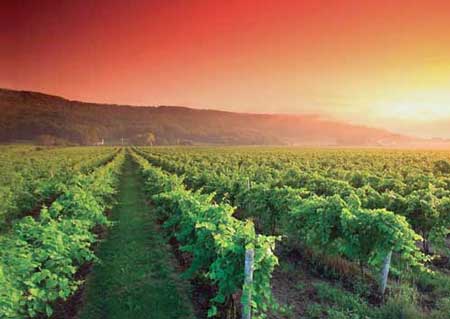VintageTexas Sunday ‘Cyclopedia of Wine: Trellising and Grapevine Canopy Management
The canopy (the canes, shoots and leaves that extend from the trunk of the grapevine) plays a key role in grape and ultimately wine quality through its ability to capture sunlight and convert it into energy for the growing vine by photosynthesis. Its other important functions include controlling water availability to the vine and grapes through transpiration and regulating the microclimate of ripening grapes.
Management of the canopy is a crucial aspect of viticulture since it effects grape yields, grape quality and the control of some grape diseases, particularly fungus and mildew. Viticultural problems like uneven grape ripening, sunburn, and frost damage, can be addressed by management and adjustment of the vine’s canopy. In Texas, important considerations are needed when selecting methods for canopy management, as:
1. Strong ambient sunlight that can ripen grapes too quickly, consume water, and even burn the fruit
2. In the wetter parts of the state, fungal infestations can damage vines and grapes
3. While Texas is a warm growing region, late Spring frosts require careful consideration of winter pruning techniques and timing, which can delay the onset of bud break.
The canopy is often manipulated and trained to guide the growth of canes and shoots to optimize grape production and quality. Several grapevine growing configurations are given below.
Vertical Shoot Positioning (VSP)
VSP trains shoots to grow upwards towards guide wires. Four canes which will produce fruit are trained to grow in opposite directions (up and down) on wires extending on two levels. The canes are sometimes sheared along the top, giving the vine a hedge-like look. This system calls for spur or cane pruning. The grapes will then be produced below the leaves, and several feet off the ground.
Geneva Double Curtain (GDC)
GDC focuses on splitting the foliage into two sections and does this by training two cordons from the trunk. These cordons grow on guide wires separated by up to about a meter. Spurs along these cordons will yield the canes that produce the grape bunches and they hang downward, so that the canopy is now divided into two curtains. This increase penetration of sunlight and thus fruit quality and the quantity that can be sustained.
Smart – Dyson (SD)
Smart Dyson (SD) system uses cordon training with two cordons, one on either side of the trunk. Each cordon bears spurs that produce the fruiting canes. As always, the cordons are permanent, and the system is subject to spur pruning. This method is also very suitable for mechanical harvesting, but, like other methods of cordon training, it also has the advantage of being suitable for mechanical pruning, and consequently has gained favor in new world growing regions (i.e. outside Europe). It is named after the developers, Richard Smart and John Dyson.
Head Training
Head-training means that the vines are not supported on a trellis system and wires but are left to grow on their own from the trunk. Many refer to this technique as “bush vines”. Head-trained vines are trained by pruning spurs that emanate out from the trunk in all directions. This is a technique found more often in older, manually harvested vineyards or where high grape production is not intended.
More information on grapevine canopy management can be found here.
— — — — —
For more information specific to grape growing in Texas, go to:
Starting a Vineyard in Texas – A Guide for Prospective Growers


Hey, I think you may have mixed up VSP and the Smart-Dyson.
In vertical shoot positioning (VSP and also known as guyot) the new shoots are only trained upwards.
In the Smart-Dyson training system, we do in fact see two cordons laid down vertically, as in the VSP system, but shoots are trained both up AND down.
There was also a training system created in Oregon called the Scott Henry. In this system, four canes are laid down (two canes on either side of the trunk) the top canes have shoots that are trained upward and the two bottom canes have shoots that are trained downward.
This paper has some really great diagrams towards the bottom, in case you are interested in a visual: http://www.idrinkwine.net/wp-content/uploads/2014/06/Trellis-Options-and-Canopy-Management-2014-ii.pdf